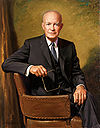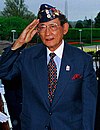List of United States Military Academy alumni
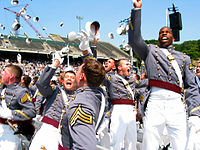

The United States Military Academy (USMA) is an undergraduate college in West Point, New York with the mission of educating and commissioning officers for the United States Army. The academy was founded in 1802 and is the oldest of the United States' five service academies.[1][2] It is also referred to as West Point (the name of the military base that the academy is a part of).[1] The academy graduated its first cadet, Joseph Gardner Swift, in October 1802. Sports media refer to the academy as "Army" and the students as "Cadets"; this usage is officially endorsed.[3] The football team is also known as "The Black Knights of the Hudson" and "The Black Knights".[3][4][5] A small number of graduates each year choose the option of cross-commissioning into the United States Air Force, United States Navy, or the United States Marine Corps. Before the founding of the United States Air Force Academy in 1955, the academy was a major source of officers for the Air Force and its predecessors. Most cadets are admitted through the congressional appointment system.[6][7] The curriculum emphasizes the sciences and engineering fields.[8][9]
The list is drawn from graduates, non-graduate former cadets, current cadets, and faculty of the Military Academy. Notable graduates include 2 American Presidents, 4 additional heads of state, 20 astronauts, 76 Medal of Honor recipients (more than any other service academy or undergraduate institution),[10] 70 Rhodes Scholars,[11] and 3 Heisman Trophy winners. Among American universities, the academy is fourth on the list of total winners for Rhodes Scholarships, seventh for Marshall Scholarships and fourth on the list of Hertz Fellowships.[12]
Academicians
[edit]- "Class year" refers to the alumni's class year, which usually is the same year they graduated. However, in times of war, classes often graduate early. For example, there were two classes in 1943 – January 1943 and June 1943.
Academics
[edit]- Note: "Class year" refers to the alumni's class year, which usually is the same year they graduated. However, in times of war, classes often graduate early.
|        |
Superintendents of the United States Military Academy
[edit]
|     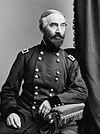 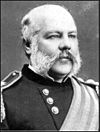    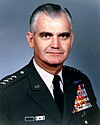 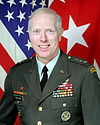   |
Commandants of the United States Military Academy
[edit]     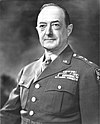    |
Top-ranking graduates
[edit]Astronauts
[edit]- Note: "Class year" refers to the alumni's class year, which usually is the same year they graduated. However, in times of war, classes often graduate early.
|   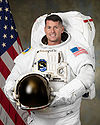 |
Authors
[edit]This a new list that requires significant work to be remotely complete. New, accurate, contributions are welcome and needed.
|
Businesspeople
[edit]- Henry A. du Pont, class of 1861, President and general manager of Wilmington & Western Railroad (1879–1899)
- Robert E. Wood, class of 1900, chairman and CEO of Sears, Roebuck (1939–1954); responsible for shifting the company's focus from a mail-order catalog company to a department store retailer; started AllState Insurance as a subsidiary of Sears; served as the Quartermaster of the Army in World War I and as chief quartermaster during the construction of the Panama Canal
- William T. Seawell, class of 1941, chairman and CEO of Pan Am Airways (1971–1981)
- Robert F. McDermott, class of 1943, former chairman and CEO of United Services Automobile Association (USAA)
- John F. Donahue, class of 1946, founder and Chairman of Federated Investors ($400 billion asset management firm)
- Frank Borman, class of 1950, President of Eastern Airlines (1975–1986)
- Walter F. Ulmer, class of 1952, President and CEO of Center for Creative Leadership (1985–1994)
- Rand Araskog, class of 1953, President, chairman, and CEO of ITT Communications
- Dana G. Mead, class of 1957, chairman and CEO of Tenneco (1994–1999), Chairman of MIT Corporation (since 2003)
- Pete Dawkins, class of 1959, former chairman and CEO of Primerica Financial Services, Vice-chairman and EVP of Travelers Insurance, Vice Chairman of Bain and Company, Vice Chairman of Citi Global Wealth Management, currently Senior Partner at Flintlock Capital
- Fred Malek, class of 1959, founder and Chairman of Thayer Capital Partners, Chairman of Northwest Airlines
- Frank J. Caufield, co-founder of venture capital firm Kleiner Perkins Caufield & Byers
- Albert Dunlap, class of 1960, CEO of Scott Paper and Sunbeam
- Jim Kimsey, class of 1962, chairman and co-founder of AOL
- Daniel W. Christman, class of 1965, Superintendent of USMA, 1996–2001; Chairman of Ultralife Corporation, SVP of International Affairs for US Chamber of Commerce (since 2003)
- John B. Ritch III, class of 1965, chairman and co-founder of Calivita International (since 1992)
- William P. Foley II, class of 1967, former CEO and current Chairman of Fidelity National Information Services
- Marshall Larsen, class of 1970, chairman and CEO of Goodrich, Corporation (since 2003)
- Bob McDonald, class of 1975, CEO of Procter & Gamble
- Ken Hicks, class of 1974, President and CEO of Foot Locker, former President of JCPenney
- William Albrecht, class of 1974, President of Occidental Oil and Gas
- Vincent Viola, class of 1977, former Chairman of NYMEX (2001–2004), CEO of VirtuFinancial, owner and member of Chairman's Council of the New Jersey Nets
- Keith McLoughlin, class of 1978, President and CEO of Electrolux
- Alex Gorsky, class of 1982, CEO of Johnson & Johnson
- Mark Green, class of 1986, founder and former CEO of Align MD
- Anthony J. Guzzi, class of 1986, President and CEO of EMCOR Group, Inc., the world's largest specialty construction, facilities services, energy infrastructure provider and a Fortune 500 company
- David McCormick, class of 1987, CEO of Bridgewater Associates, one of the world's largest hedge funds, from 2020 to 2022. Named president of FreeMarkets in 2001 and was named chief executive officer in 2002; he successfully sold FreeMarkets to Ariba in 2004 for approximately $500 million.
- Mark Clouse, class of 1990, President and CEO of Campbell Soup Company
- Anthony Noto, class of 1991, former CFO and COO of Twitter and current CEO of SoFi
- John Ham, class of 2000, Ustream Founder, CEO and Chairman
- Brad Hunstable, class of 2001, founder and President of Ustream.TV
Engineers
[edit]
|   |
Government
[edit]Heads of state or government
[edit]Directors of the Central Intelligence Agency
[edit]- Hoyt Vandenberg, class of 1923, DCI 10 June 1946 – 1 May 1947
- David Petraeus, class of 1974, DCIA 6 September 2011 – 9 November 2012
- Mike Pompeo, class of 1986, DCIA 23 January 2017 – 26 April 2018 (became United States Secretary of State)
Cabinet members
[edit]- Andrew J. Donelson, class of 1820, President's Secretary (1829–1837)
- Jefferson Davis, class of 1828, United States Secretary of War (1853–1857)
- Montgomery Blair, class of 1835, United States Postmaster General (1861–1864)
- William Tecumseh Sherman, class of 1840, United States Secretary of War (1869)
- Gustavus Woodson Smith, class of 1842, Confederate States Secretary of War (1862)
- John Schofield, class of 1853, United States Secretary of War (1868–1869)
- Marshall Carter, class of 1931, Deputy Director of Central Intelligence (1962–1965) and Director of the National Security Agency (1965–1969)
- Rafael M. Ileto, class of 1943, Philippine Secretary of National Defense (1986–1988)
- Brent Scowcroft, class of 1947, National Security Advisor (1974–1977, 1989–1993)
- Alexander Haig, class of 1947, United States Secretary of State (1981–1982)
- Fidel V. Ramos, class of 1950, Philippines Secretary of National Defense (1988–1991)
- John Block, class of 1957, United States Secretary of Agriculture (1981–1986)
- Jim Nicholson, class of 1961, United States Secretary of Veterans Affairs (2005–2007)
- Barry McCaffrey, class of 1964, US Drug Czar (1996–2001)
- Eric K. Shinseki, class of 1965, United States Secretary of Veterans Affairs (2009–2014)
- James Peake, class of 1966, United States Secretary of Veterans Affairs (2007–2009)
- Robert Alan McDonald, class of 1975, United States Secretary of Veterans Affairs (2014–2017)[162]
- Mike Pompeo, class of 1986, United States Secretary of State (2018–2021), former Director of the Central Intelligence Agency (2017–2018)
- Mark Esper, class of 1986, 27th United States Secretary of Defense (2019–2020), former 23rd United States Secretary of the Army (2017–2019)
- Lloyd Austin, class of 1975, 28th United States Secretary of Defense (2021–present)
Secretaries of the Army
[edit]- Howard Hollis Callaway, class of 1949, 11th United States Secretary of the Army (1973-1975)
- Louis Caldera, class of 1978, 17th United States Secretary of the Army (1998-2001)
- Thomas E. White, class of 1967, 18th United States Secretary of the Army (2001-2004)
- Mark Esper, class of 1986, 23rd United States Secretary of the Army (2017–2019)
Ambassadors
[edit]
|  |
- Andrew J. Donelson, class of 1820, Chargé d'affaires of the United States to the Republic of Texas (1845), U.S. Minister to Prussia (1846–49), U.S. vice presidential candidate (1856)
- Rufus King, class of 1833, U.S. Minister to the Papal States (1863–1867)
- William Woods Averell, class of 1855, U.S. Consul General to British North America (1866–1869)
- Hugh Judson Kilpatrick, class of 1856, U.S. Minister to Chile, 1866–70, 1881
- Frederick Dent Grant, class of 1871, U.S. Minister to Austro-Hungarian Empire (1890–1893)
- James Maurice Gavin, class of 1929, U.S. Ambassador to France (1961–62)
- John Eisenhower, class of 1944, U.S. Ambassador to Belgium (1969–1971)
- David Manker Abshire, class of 1951, U.S. Ambassador to NATO (1983–1987)
- John Galvin, class of 1954, U.S. Ambassador to Bosnian Peace Negotiations[169]
- Jim Nicholson, class of 1961, U.S. Ambassador to the Vatican (2001–2005)
- John B. Ritch III, class of 1965, U.S. Ambassador to United Nations International Organizations in Vienna (1993–2001)
- Robert M. Kimmitt, class of 1969, U.S. Ambassador to Germany (1991–1993)
- William B. Taylor Jr., class of 1969, U.S. Ambassador to Ukraine (2006–2009, 2019–2020)
- Karl Eikenberry, class of 1973, U.S. Ambassador to Afghanistan (2009–2011)
- Matthew Klimow, class of 1974, U.S. Ambassador to Turkmenistan (2019–present), acting State Department Inspector General (2020)
Governors (civil)
[edit]
|   |
- Robert Francis Withers Allston, class of 1821, Governor of South Carolina (1856–58)
- David Wallace, class of 1821, Governor of Indiana (1837–1840)
- Robert Milligan McLane, class of 1837, Governor of Maryland (1884–85)
- Isaac Ingalls Stevens, class of 1839, Governor of Washington Territory (1853–1857)
- George Stoneman, class of 1846, Governor of California (1883–1887)
- George B. McClellan, class of 1846, Governor of New Jersey (1878–81)
- Ambrose Burnside, class of 1847, Governor of Rhode Island (1866–69)
- Francis Redding Tillou Nicholls, class of 1855, Governor of Louisiana (1877–80, 88–92)
- William H. Upham, class of 1866, Governor of Wisconsin (1895–1897)
- Alexander Oswald Brodie, class of 1870, Governor of Arizona Territory (1902–05)
- Charles H. Martin, class of 1887, Governor of Oregon (1935–39)
- Chester Harding, class of 1889, Governor of Panama Canal Zone (1917–21)
- Jay Johnson Morrow, class of 1891, Governor of Panama Canal Zone (1921–24)
- Meriwether L. Walker, class of 1893, Governor of Panama Canal Zone (1924–28)
- Harry Burgess, class of 1895, Governor of Panama Canal Zone (1928–32)
- Clarence S. Ridley, class of 1905, Governor of Panama Canal Zone (1936–40)
- Glen E. Edgerton, class of 1908, Governor of Panama Canal Zone (1940–44)
- Joseph C. Mehaffey, class of 1911, Governor of Panama Canal Zone (1944–48)
- Francis K. Newcomer, class of 1913, Governor of Panama Canal Zone (1948–52)
- John S. Seybold, class of 1920, Governor of Panama Canal Zone (1952–56)
- William E. Potter, class of 1933, Governor of Panama Canal Zone (1956–60)
- William A. Carter, class of 1930, Governor of Panama Canal Zone (1960–62)
- Robert John Fleming, class of 1928, Governor of Panama Canal Zone (1962–67)
- David Stuart Parker, class of 1940, Governor of Panama Canal Zone (1971–75)
- Harold Parfitt, class of 1943, Governor of Panama Canal Zone (1975–79)
- Warren E. Hearnes, class of 1946, Governor of Missouri (1965–1973)
- Dave Heineman, class of 1970, Governor of Nebraska (2005–2015)
- John Bel Edwards, class of 1988, Governor of Louisiana (2016–2024)
Governors (military)
[edit]
|  |
- Thomas Childs, class of 1814, military governor of Puebla, Mexico
- John H. Martindale, class of 1835, military Governor of Washington, D.C.
- Rufus Saxton, class of 1849, military governor of the Department of the South
- Fitzhugh Lee, class of 1856, military governor of Havana, Cuba
- Philip Sheridan, class of 1853, military governor of the Fifth Military District
- Douglas MacArthur, class of 1903, military governor of Japan
- George S. Patton, class of 1909, military governor of Bavaria
- Joseph T. McNarney, class of 1915, military governor of U.S. Occupation Zone, Germany
- Matthew Ridgway, class of 1917, military governor of Japan
- Lucius D. Clay, class of 1918, military Governor in West Germany noted for Berlin Airlift
Legislators
[edit]
|    |
- Daniel Azro Ashley Buck, class of 1808, U.S. Representative (1823–1825, 1827–1829), Vermont
- Daniel Tunern, class of 1814, U.S. Representative, North Carolina (1827–1829)
- James Monroe, class of 1815, U.S. Representative (1839–1841), New York
- George Wurtz Hughes, class of 1827, U.S. Representative (1859–1861), Maryland
- Jefferson Davis, class of 1828, U.S. Representative (1845–1846) and Senator (1847–1853, elected but not seated 1875), Mississippi
- Alexander C.M. Pennington, class of 1828, represented New Jersey's 5th congressional district in the United States House of Representatives 1853–1857[183]
- Joseph E. Johnston, class of 1829, U.S. Representative, Virginia
- Henry Bell Van Rensselaer, class of 1831, U.S. Representative, New York
- Robert Milligan McLane, class of 1837, U.S. Representative, Maryland
- John B. S. Todd, class of 1837, U.S. Congressman, Dakota Territory (1861–1863, 1864–1865)
- James Madison Leach, class of 1838, U.S. Representative, North Carolina
- Isaac Ingalls Stevens, class of 1839, U.S. Representative, Washington Territory
- Egbert Ludoricus Viele, class of 1847, U.S. Representative, New York
- Ambrose Burnside, class of 1847, U.S. Senator, Rhode Island (1875–1881)
- Henry Warner Slocum, class of 1852, U.S. Representative, New York (1869–1873, 1883–1884)
- Henry A. du Pont, class of 1861, U.S. Senator, Delaware (1895–1896, 1906–1917)
- Joseph Wheeler, class of 1859, U.S. Representative, Alabama (1881–1882, 1883, 1885–1900)
- Frank Obadiah Briggs, class of 1872, U.S. Senator, New Jersey
- Jesse Matlack Baker, class of 1873, Pennsylvania State Representative (1889-1892) and State Senator (1893-1897)
- Lawrence D. Tyson, class of 1883, U.S. Senator, Tennessee (1925–1929)
- Bertram Tracy Clayton, class of 1886, U.S. Representative, New York (1899–1901)
- Charles Henry Martin, class of 1887, U.S. Representative, Oregon
- Butler Ames, class of 1894, U.S. Representative, Massachusetts
- Frank Kowalski, class of 1930, U.S. Representative from Connecticut
- Nile Soik, class of 1945, member of the Wisconsin State Legislature[184]
- Howard Hollis Callaway, class of 1949, U.S. Representative, Georgia (1965-1967)
- John Michael Murphy, class of 1950, U.S. Representative, New York (1963-1981)
- Adam Benjamin Jr., class of 1958, U.S. Representative, Indiana (1977–82)
- Jack Reed, class of 1971, U.S. Representative (1991–1997), U.S. Senator (1997- ), Rhode Island
- John Shimkus, class of 1980, U.S. Representative, Illinois (1997– 2021)
- Geoff Davis, class of 1981, U.S. Representative, Kentucky (2004– 2012)
- Mike Pompeo, class of 1986, U.S. Representative, Kansas (2011–2017)
- Mark Green, class of 1986, U.S. Representative, Tennessee (2019– )
- Brett Guthrie, class of 1987, U.S. Representative, Kentucky (2009– )
- Warren Davidson, class of 1995, U.S. Representative, Ohio (2016– )
- Steve Watkins, class of 1999, U.S. Representative, Kansas (2018– )
- Pat Ryan, class of 2004, U.S. Representative, New York (2022– )
- John James, class of 2004, U.S. Representative, Michigan (2023–)
- Wesley Hunt, class of 2004, U.S. Representative, Texas (2023–)
Mayors
[edit]
|
- William Lewis Cabell, class of 1850, Mayor of Dallas, Texas (1874–76, 1877–79, 1883–85)
- Frank Fischl, class of 1951, Mayor of Allentown, Pennsylvania (1978–1982)[186]
- Robert M. Isaac, class of 1951, Mayor of Colorado Springs, Colorado (1979–1997)
- Matthew Collier, class of 1979, Mayor of Flint, Michigan (1988–1992)
- Maria Vedder Lowe, class of 1998, Mayor of St. Pete Beach, Florida (2014–2016)[187]
- Adrian Perkins, class of 2008, Mayor of Shreveport, Louisiana (2018–2022)
Jurists
[edit]- John Archibald Campbell, ex-class of 1830, Associate Justice of the Supreme Court of the United States (1853-1861)
- Montgomery Blair, class of 1835, attorney for Dred Scott in landmark 1857 Supreme Court case Dred Scott v. Sandford, 20th United States Postmaster General (1861–1864)
- Francis Redding Tillou Nicholls, class of 1855, Chief Justice Louisiana Supreme Court (1892–1911)
- Richard Whitehead Young, class of 1882, Philippines Supreme Court Justice (1899–1901)
- Richard D. Cudahy, class of 1948, Judge on the United States Court of Appeals for the Seventh Circuit (1979-2015)
- Malcolm Jones Howard, class of 1962, Judge, United States District Court Eastern District of North Carolina (1987–2005)
- Mike Bowers, class of 1963, Georgia's longest-serving Attorney General (1981–1997)
- Eugene R. Sullivan, class of 1964, Chief Judge United States Court of Appeals for the Armed Forces (1986–2002)
- Rhesa Barksdale, class of 1966, U.S. Court of Appeals for the Fifth Circuit (1990–2009)
- Roy Moore, class of 1969, Chief Justice Alabama Supreme Court (2001–2003, 2013–2017)
- Bruce E. Kasold, class of 1973, Judge on the United States Court of Appeals for Veterans Claims (2003-2016)
Law enforcement and intelligence figures
[edit]- Fitz John Porter, class of 1845, New York City Police Commissioner
- William Farrar Smith, class of 1845, New York City Police Commissioner
- Frederick Dent Grant, class of 1871, New York City Police Commissioner
- Dario Lorenzetti, class of 1993, CIA Officer killed in Afghanistan
- Douglas I. McKay, class of 1905, New York City Police Commissioner
- Norman Schwarzkopf Sr., class of 1917
- Alva Revista Fitch, class of 1930
- Barry McCaffrey class of 1964, Drug Czar during Clinton Administration
- Donald B. Smith class of 1969, New York State Sheriff Association President, Putnam County Sheriff 2002–2018
- Keith B. Alexander class of 1974, Head of the National Security Agency, General – Commander of Cyber Command
- Lon Horiuchi, class of 1976
Literary figures and actors
[edit]
|
- Henry Martyn Robert, class of 1857, author of Robert's Rules of Order
- William James Roe, class of 1867, author of satirical and metaphysical works, poet and artist
- John Wilson Ruckman, class of 1883, first editor of Journal of U.S. Artillery, author of numerous technical articles on gunnery
- Herbert H. Sargent, class of 1883, author of Napoleon Bonaparte's First Campaign, The Campaign of Marengo and The Campaign of Santiago de Cuba
- Cornelis DeWitt Willcox, class of 1885
- Col. Mark M. Boatner III, class of June 1943, author of Civil War Dictionary, Encyclopedia of the American Revolution
- Hal Moore, class of 1945, author of We Were Soldiers Once...And Young
- James Salter, class of 1945, prolific author, selected to the Academy of Arts and Letters
- Bill McWilliams, class of 1955, author of A Return To Glory
- Gus Lee, ex-class of 1966, honorary member of the class of 1970, author of China Boy, Chasing Hepburn
- Lucian Truscott IV, class of 1969, journalist and author of Dress Grey
- Brian Haig, class of 1975, novelist
- James Carafano, class of 1977, author of Winning the Long War
- Mark Valley, class of 1987, TV and movie actor
- Col. Gregory D. Gadson, class of 1989, movie actor
- Paula Broadwell, class of 1995, author
Military figures
[edit]Medal of Honor recipients
[edit]Civil War
[edit]
|       |
Indian Wars
[edit]
|      |
Spanish–American War
[edit]
|  |
Philippine–American War
[edit]
|  |
Boxer Rebellion
[edit]
|
Mexican Campaign (Veracruz)
[edit]
| 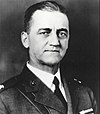 |
World War I
[edit]
|
World War II
[edit]
|   |
Korea
[edit]
|
Vietnam
[edit]
|   |
Mexican–American War combatants
[edit]
|  |
American Civil War combatants
[edit]Confederate States Army generals
[edit]
|    |
Union Army generals
[edit]
|


 French
French Deutsch
Deutsch